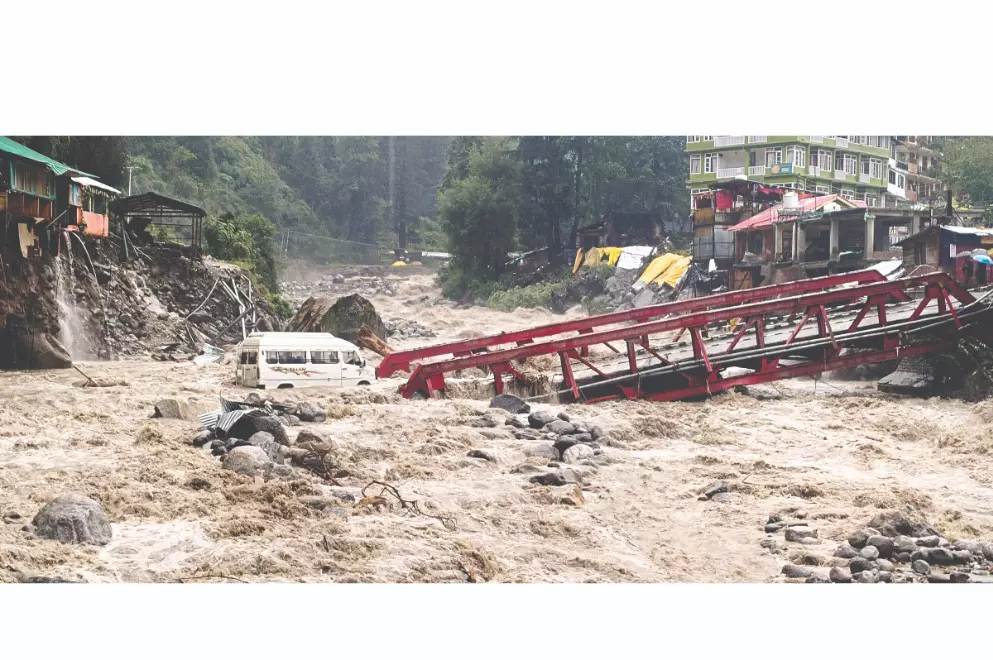Rain showers misery on north India

New Delhi: Persistent rainfall continued to wreak havoc across north India, as swollen rivers, landslides, and flash floods disrupted daily life, caused massive evacuations, and forced widespread closures. Authorities have warned that the worst may not yet be over, urging residents to exercise extreme caution.
In the National Capital Region, unusual heavy showers for this time of the year caused extensive waterlogging, halting traffic in several parts of Gurugram. Villages near Sector 63A were submerged after the Aravali dam near Kadarpur suffered severe damage. In Delhi, residents living along the Yamuna floodplains moved to safer locations as the river breached the danger mark, reaching 206.03 metres at 4 pm. The Old Railway Bridge has been closed, and the Central Flood Control Room issued warnings that water levels could rise further. Chief Minister Rekha Gupta assured that the government was prepared to handle the situation. The city’s primary weather station recorded 37.8 mm of rainfall.
Punjab continued to struggle with its worst flooding since 1988, as the Sutlej, Beas, and Ravi rivers and numerous rivulets remained swollen. Twelve districts have been severely affected, claiming 29 lives and impacting more than 2.56 lakh people. Neighbouring Haryana, along with Chandigarh, also experienced heavy rainfall. Schools in Chandigarh and Haryana remained closed on Tuesday, while colleges, universities, and polytechnic institutes in Punjab are ordered to remain shut until September 3. Relief and rescue operations are ongoing, with over 16,000 people evacuated so far by the NDRF, Army, BSF, and local authorities. Himalayan states faced similar challenges. Uttarakhand recorded heavy showers, prompting closures of schools and anganwadi centres in districts including Dehradun. The Chardham Yatra has been suspended until September 5, as rivers such as the Ganga, Mandakini, and Alaknanda remain in spate. The state has already reported 79 deaths, 114 injuries, and 95 missing people due to monsoon-related disasters this year.
In Himachal Pradesh, torrential rainfall triggered landslides and flash floods, killing two women and forcing the closure of more than 1,000 roads. An orange alert was issued for Kangra, Mandi, Sirmaur, and Kinnaur districts. Shimla’s government and private educational institutions, including coaching and nursing centres, were ordered to remain shut. Nine villages in Manali were cut off due to flooding of the Manalsu stream, while a landslide in Mandi damaged two houses. Train services on the Shimla-Kalka route, suspended due to landslips, will remain halted until September 5. Efforts are underway to safely return approximately 5,000 Manimahesh pilgrims, with 16 pilgrims having died since the yatra began on August 15.
The Jammu region faced further disruption as mudslides and boulders blocked the Jammu-Srinagar highway, isolating the Kashmir Valley. Since August 14, more than 130 people, mainly pilgrims, have died and over 120 were injured in Kishtwar, Kathua, Reasi, and Ramban districts due to landslides, cloudbursts, and flash floods. Pilgrimage to the Mata Vaishno Devi shrine has been suspended for eight consecutive days.
Meanwhile, in eastern India, a low-pressure area over the Bay of Bengal brought heavy rainfall to Odisha, which is expected to continue for the next four days. Coastal areas, including Bhubaneswar and Cuttack, reported waterlogging, while a bridge at Kangurkonda connecting Malkangiri and Motu was submerged, affecting road links to Andhra Pradesh and Telangana. South Bengal and Sagar Island have also received significant rainfall, with 120 mm reported in the latter. Arunachal Pradesh is forecast to see scattered to widespread rainfall over the next five days, prompting the IMD to caution residents to follow disaster management guidelines to prevent accidents and disruptions.
Authorities across the country continue to monitor river levels and weather systems, maintaining readiness for relief operations as the monsoon season proves increasingly destructive.



